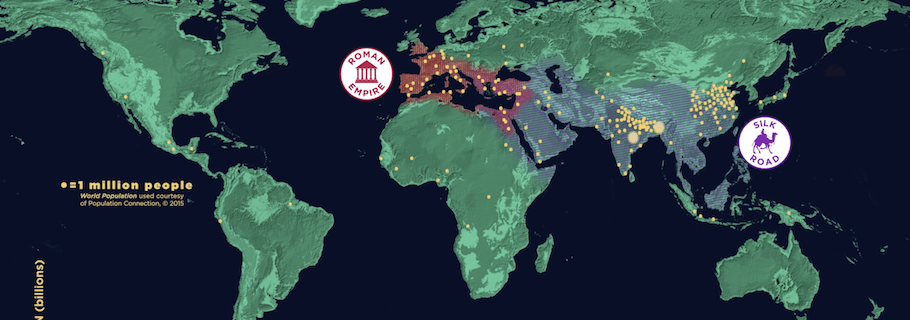From “In the beginning God created the heavens and the earth” to 1800 AD. That’s how long it took for earth to reach a population of 1 billion people. The next billion took just 130 years, the one after that 30 years, then 15, then 13. By the new millennium, earth’s population had reached 6 billion and today it stands north of 7 billion. Consensus seems to be that falling birth rates are causing population growth to level off, finally slowing the rate of increase. Though growth will continue for the foreseeable future, it may take more than 200 years before the earth’s population doubles to 15 billion.
The American Museum of Natural History recently put together an incredible presentation of this data. Beginning with a map of our planet, it shows humanity spreading across the globe. (Note: Christians may disagree with the starting location and the first few seconds of the timeline.) They then begin to display earth’s population through a series of dots, each of which represents 1 million people. Noteworthy events appear along a timeline—innovations, dynasties, conquests, plagues. Here’s how I saw the presentation:
- When Jesus is born there are about 170 of these dots clustered in the Middle East, Europe, China, and India.
- When Saint Augustine lives and dies that number has barely increased, though by the time of Aquinas it has doubled.
- When Luther launches the Reformation earth is almost halfway to a billion and by Jonathan Edwards’ lifetime the pace has increased and is heading toward 800 million.
- When earth finally hits a population of 1 billion, William Carey has launched the modern missions movement and Christian missionaries are spreading to the four corners of the earth.
- A hundred years later earth is approaching 2 billion and, despite plagues and world wars, it grows explosively through the twentieth century.
- It continues to grow into the twenty-first and, based on current projections, will not stop growing until the twenty-second.
You should watch the 6-minute presentation and see it for yourself:
The Museum means to make a point with this video and it appears their concern is related to family planning, consumption, pollution, and ecology. They are worried that this relentless growth is going to harm earth’s inhabitants while destroying their planet.
I will put that concern aside to make a point that is of greater interest to me: the Great Commission. I think we have a tendency to look to Christian history and assume that most of the work has already been done. We’ve taken the gospel to every corner of the earth, right? What was begun by Carey and other committed missionaries has spread far and wide and now we’ve entered into a mopping-up phase: We just need a few passionate people to learn the last few languages and go to those final far-off places.
That may be somewhat true when it comes to geography—is there a country remaining that has no ongoing mission work? Is there a major people group that is utterly devoid of witness? But if we look through the lens of population we see that, actually, most of the work remains to be done. We’re only just getting started! There are 7 times more people in the world today than there were during the great age of Christian missions. Sure, there are more Christians as well, but billions and billions of people still don’t know Christ. Billions more will be born in the years ahead. Measured by world population—immortal souls created in God’s image!—we’ve only barely made a dent.
I see this video and realize the greatest age of missions lies ahead. The greatest number of Christians remains to be born and to be born again.










